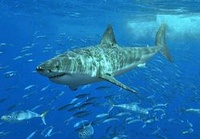
The great white is classified as a mackerel (Lamnidae) shark. There are four other living species in this family, two mako and two Lamna sharks. Dental features and the extreme size of both the Great White and the prehistoric Megalodon lead many scientists to believe they were closely related, and the name Carcharodon megalodon was applied to the latter. At present there is considerable doubt about this hypothesis, and other scientists would place the megalodon and white shark as distant relatives - sharing the family Lamnidae but no closer relationship. Megalodon is only known from its teeth and from a few cartillage remains, and probably reached sizes of 12 metres (40 ft) or more, considerably larger than even the largest great white sharks. From time to time it is suggested that megalodon might still exist. Megalodon teeth have supposedly been found from as recently as 10,000 to 12,000 years ago, but these results appear to be based on misinterpretation of the evidence. However, while megalodon fossils are widespread and plentiful, no evidence has surfaced that the species is anything but extinct. Other evidence suggests that the great white shark is more closely related to the mako shark than to the megalodon. The Carcharocles and Otodus obliquus sharks are in this case considered the ancient representatives of the extinct megalodon lineage; indeed, Carcharocles megalodon is a popular alternative classification of the megalodon. Great white sharks live in almost all coastal and offshore waters which have a water temperature of between 12 and 24° C (54° to 75° F), with greater concentrations off the southern coasts of Australia, off South Africa, California, Mexico`s Isla Guadalupe and to a degree in the Central Mediterranean and Adriatic Seas. One of the densest known populations is found around Dyer Island, South Africa where much research on the shark is conducted. It can be also found in tropical waters like those of the Caribbean and has been recorded off Mauritius. It is a pelagic fish, but recorded or observed mostly in coastal waters in the presence of rich game like fur seals, sealions, cetaceans, other sharks and large bony fish species. It is considered an open-ocean dweller and is recorded from the surface down to depths of 1,280 metres (4,200 ft), but is most often found close to the surface. In a recent study great white sharks from California were shown to migrate to an area between Baja California and Hawaii, where they spend at least 100 days of the year before they migrate back to Baja. On the journey out, they swim slowly and dive to up to 900 metres (3,000 ft). After they arrive, they change behaviour and do short dives to about 300 m (1,000 ft) for up to 10 minutes. It is still unknown why they migrate and what they do there; it might be seasonal feeding or possibly a mating area. In a similar study a great white shark from South Africa was tracked swimming to the northwestern coast of Australia and back to the same location in South Africa, a journey of 20,000 kilometres (over 12000 miles) in under 9 months